-
Posts
2,284 -
Joined
-
Last visited
-
Days Won
6
Content Type
Profiles
Forums
Blogs
Gallery
Events
Store
Posts posted by PKeating
-
-
Apart from his 41 or 43 victories - depending on the source - what makes Stollnberger special?
PK

 0
0 -
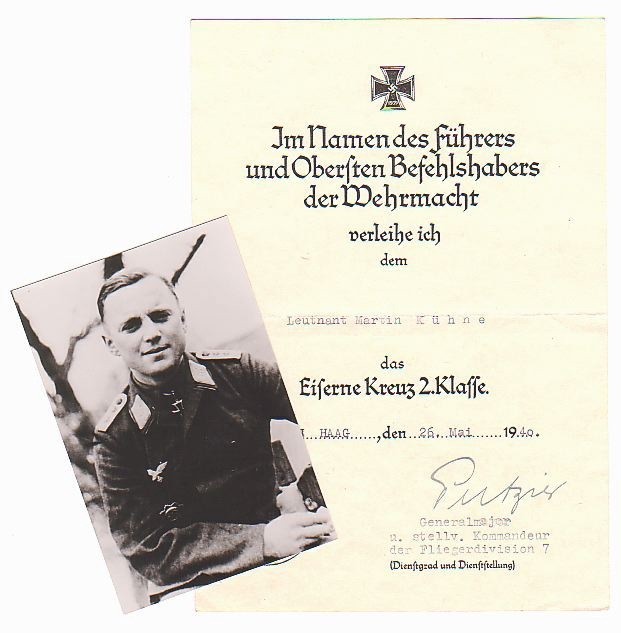
Let?s see your Fallschirmtruppe EK2 award documents. To kick things off, here is a classic Fall Gelb document, issued in the Hague and signed by Generalmajor Putzier, who took temporary command of 7. Fliegerkorps after General Student took an accidental bullet in the head from a nervous SS-VT soldier who happened to be passing and took a potshot when Student looked out the window of his command post.
Martin K?hne, who died quite recently, was born in 1918 and had what used to be known as ?a good war?. Oberfahnrich K?hne came to Fallschirmj?ger-Regiment 1 from Flak-Rgt 10 in 1939, completing his parachute training at Wittstock. K?hne ended the war as a Major with Fallschirmj?ger-Rgt 10. He held the Ritterkreuz, DKiG, Ehrenpokal, EK1, EK2 and VAiS (Black Wound Badge). He fought in Holland, Greece, Crete, Russia, North Africa, Italy and other places in the Mediterranean theatre of operations.
In April 1940, Leutnant K?hne was a Zugf?hrer (Platoon Commander) in 2./Fallschirmj?ger-Erganzungs-Btl 1 at Stendal. This sub-unit was sent to Twede Tol with others to create a reserve from which replacements and reinforcements could move easily by requisitioned vehicles, including bicycles, to the south end of the Moerdijk bridges and North Dordrecht. However, he was apparently with 15./FJR1 as a platoon commander for the Moerdijk jump and certainly saw action during the battle, winning this EK2 for leading a successful assault on a heavily defended bunker, an action in which he was wounded. Perhaps someone here can shed more light on this.
At Corinth, K?hne and his men captured British anti-aircraft battery and took many prisoners. K?hne was recommended for the Ritterkreuz but received the EK1 instead. In North Africa, he took part in the Ramckebrigade?s extraordinary two-hundred mile trek from El Alamein back to German lines in November 1942, for which he received the DKiG. He fought at Anzio-Nettuno, Cassino and other places but his finest moment was Fall Leopard, the capture of the Greek island of Leros in November 1943, which brought him the Ritterkreuz. By then, Hauptmann K?hne was CO of I./Fallschirmj?ger-Rgt 2.
Leros was defended by an 8550-strong Anglo-Italian force, commanded by the British General Tillney and supported by heavy artillery. The airborne element of the attacking force comprised elements of I./FJR2, 15. (Fallschirm) Kompanie and elements of 22. Luftlande-Division. The seaborne element consisted of the Brandenburg Division?s III./Leichtes-Infanterie-Rgt, assisted by Brandenburger K?stenj?ger-Abteilung (Coastal Raiders) commandos.
Just after 1300 hrs on 12.11.1943, 2. and 4./FJR2 jumped with the Brandenburg Division?s 15. (Fallschirm) Kompanie and moved quickly off the DZ to capture Monte Rachi, one of the highest points on Leros. Once the Fallschirmj?ger had driven a wedge between the defending forces in the north and south by the afternoon of 13.11.1943, the rest of I./FJR2 jumped as other reinforcements were arriving by sea. However, the defenders were resisting ferociously and victory was by no means a certainty for the Germans.
On 14.11.1943, supported by Stukas, the Fallschirmj?ger mounted an assault on the British HQ on Monte Meroviglia but were beaten off and had to fall back to their positions on Monte Rachi. The next day, K?hne pulled his paras from their shellscrapes and shallow trenches and they stormed Monte Meroviglia, routing the defenders. On 16.11.1943, Leutnant Max Wandrey, commanding the Brandenburg paras, captured General Tillney. By nightfall on 18.11.1943, all Allied forces on Leros had surrendered.
This document was reportedly given to the author Klaus Peters by Martin K?hne as a present when Peters was researching his two-volume photo-history of Fallschirmj?ger-Regiment 3. The document was acquired by George Petersen who later sold it to Robert Queenm from whom I bought it, thanks to my friend Eric Queen, author of Red Shines The Sun, the definitive reference book on the Heer's Fallschirm-Infanterie-Kompanie/Bataillon, many former members of which formed the cadre of FJR3 via II./FJR1. I believe the rest of Martin K?hne's documents remain with his family, including the formal Ritterkreuz document, K?hne being one of the relatively few to receive a formal document at that stage of the war.
Paddy Keating
0 -
Hard to say. I would tend to view it as unfortunate. That said, I have Martin K?hne's EK2 document for Moerdijk in 1940, when he was with II./Fallschirmj?ger-Rgt 1. K?hne got the RK for Leros as CO of I./FJR2 in 1943 and the DKiG at Cassino.
The rest of the group remains with the family but Herr K?hne apparently made a present of the EK2 document to Klaus Peters when the latter was researching his Fallschirmj?ger-Rgt 3 books. Peters sold the document to George Petersen afterwards, who subsequently sold it to Robert Queen, from whom I acquired it. It's the closest I have so far come to a Fallschirmj?ger RKT in document terms. I missed the Witzig preliminary document for Eben Emael a couple of years ago. Had K?hne not given this EK2 document to Peters, I wouldn't have it now. Should I offer it back to the K?hne family? Is it unethical to keep it? Am I perpetuating group-splitting?
Uncomfortable questions, aren't they? How many of us have things in our collections that might not bear close scrutiny in an ethical context? I don't think the veterans who gave things to Klaus Peters intended that he should turn around and sell them as soon as he had finished his books. Peters has been criticised in the past for this by various people but some might argue that the recipient of a gift is free to do whatever he likes with that gift. Tricky issue! Maybe other members can give their opinions.
Veterans often make gifts like this to people they like. It explains why so many German groups are missing EK2 documents! They have the right to do this because no money is involved. The shame is that the recipients of such gifts sometimes sell them afterwards. There again, I suppose they have the right to sell them. I think the question of ethics only arises when a complete group is acquired by a dealer or a collector who then breaks it up for financial gain. A veteran has the right to do whatever he likes with his awards and effects. I would always advise veterans against splitting but would never view them in the same light as a dealer or collector who splits up a group.
PK

 0
0 -
Splitting up groups is vandalism. If collectors cannot afford high end groups like the ones seen on the market in the last couple of years, then the asking prices are simply too high. Selling and buying items from groups recently split up should be treated in the same way we treat the issue of trading in stolen items. It should attract the same stigma. We can perhaps forgive splittings that occurred years and decades ago but there should be zero tolerance for it today. Oh, and I have "put up", in that I have several groups that are unsaleable as a whole because of artificially inflated price levels. I could sell them if I broke them up but I won't. So I am left with groups that are valuable but unsaleable as things stand. I managed to rescue one of the groups and some of the man's photos but not before his album had been ripped to shreds and sold off piecemeal. I got some of the photos from it, including a set of snapshots from 1944 with greetings written in the 1950s by survivors on the veteran's business cards. These had been mounted on a page in the album. But the rest were scattered to the four winds. Nobody will ever convince me that this is a defensible practice. In this case, the man had wanted his papers and photos to go to someone he had nominated but his family disregarded that as soon as the dealer called up with a cash offer. Bloody vultures!
PK
0 -
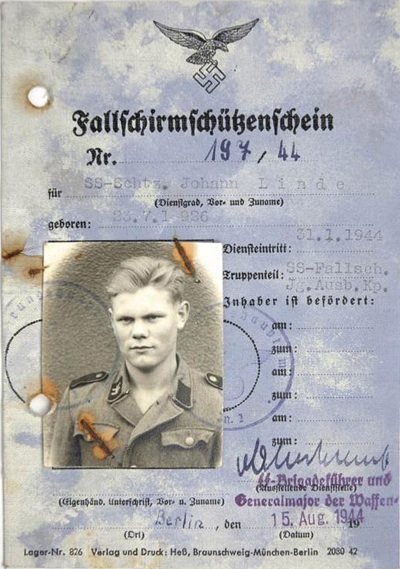
The good news for today is that I'm beginning to think this FSS might be original. That's the effect the fakers and bent dealers have on our hobby. They render us cautious to the point of paranoia. Of course, this image isn't good enough by itself but there is another known original FSS, part of a grouping, that looks very like this one. I still think certain things look odd about it but other things appear spot-on.
You can never be too careful...
PK
0 -
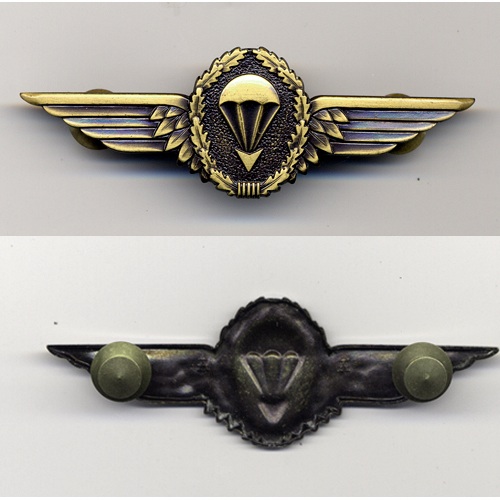
These are the wings we were awarded. Note the Assmann logo, which hasn't changed since WW2. Assmann was one of the firms supplying Luftwaffe parachutist badges to the OKW and OKL. Of course, we wore embroidered versions on our jump smocks.
PK
0 -
These are the wings they awarded us. Note the Assmann logo on the reverse. Of course, we wore embroidered versions on our smocks.
PK

 0
0 -
The last aluminium Type 1 I saw changing hands privately involved more than $3,500.00. This is a 'transitional' variant. Some people are put off by the deformity around the diving eagle's talons but if you're what might be termed 'an advanced collector' of Heer para badges, this would be a bonus rather than a minus, given the rarity of these intermediate badges. It is quite amazing that Juncker even allowed them out the door!
It's hard to put prices on some things. Wolfe-Hardin sold a cased aluminium Type 2 to a punter for more than $7k recently, having bought it for about $4k. A zinc example went for a reported $3,250.00 through the WAF eStand a couple of months ago. But I wonder if these prices are aberrational. W-H obviously had a moneyed client prepared to pay whatever it took to fill a gap and knew they could milk him for twice what the handful of people in the market for these badges would actually pay. Whoever bought the zinc badge clearly had the maxim about paying tomorrow's price today in mind but I think he'll have to wait quite some time for real values to catch up.
If I put, say, a perfect Type 2 aluminium badge up for $3,500.00, I would be surprised if it realised that price. The same applies to a perfect 1943/44 zinc type. A good Type 1 might just see $3,500.00 but the market for these badges is really quite limited. Someone who is quite a serious collector asked me to sell him a nice Type 2 aluminium badge recently and balked when I told him that I couldn't go below ?2,500.00. This is slightly more than the US dollar price of the zinc one I mentioned.
This is the problem when you get some dealers and collectors trying to rachet up prices artificially. It messes up things for everyone by rendering their stuff hard to sell. Oh, sure, you can sell your gear for the price you deem reasonable and in line with reality but how will you feel when you see it changing hands shortly afterwards for 40% more? I tried to sell a beautiful Type 1 E-Boat badge by Schwerin recently for about 30% less than the dealers were asking for examples that weren't as nice. Not even one enquiry! The owner eventually sold it here in France for ?800.00, which isn't much more than half its value.
In short, these things are worth what people are willing to pay for them on a regular basis, not what one or two examples realised in unrepresentative sales. Look at the Haug Heer para group sold through Hermann Historica: the buyer clearly had more money than sense. I would be astonished if he ever saw the ?60k-plus he paid back. Result? A silver badge I could have had, with a case, for $12k a while ago suddenly shot up to $22k, without the case. I can see the vendor's point of view but at the same time, mad millionaire buyers aren't that thick on the ground in our hobby, despite all the rumours about Spielberg, Hanks, Eastwood, Jagger and so on.
PK
0 -
No, but I jumped with their sons and grandsons...
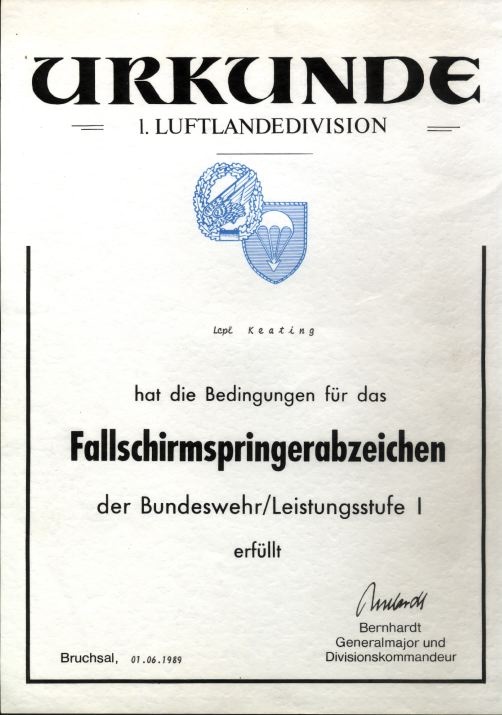
 0
0 -
Someone made the vendor an off-site offer. By that time, the bidding was past $2,200.00, which is less than you would pay for a Type 2.
PK
0 -
One has to look at this in the context of a time when common soldiers and sailors could be given 200 lashes for having something minor wrong with their uniform on duty or 600 lashes for being late on parade. Byng was certainly a martyr to official incompetence but one wonders how many sailors were subjected to monstrous punishments by Byng. This is not to justify what was done to Byng but let's not forget that the majority of Royal Navy officers were utter bastards. You had to be, to survive the rigours of such a career. At least he was shot, a quick death by comparison with hanging as implemented at the time, which was the fate of sailors for a wide range of offences ranging from relatively minor to cowardice. They were brutal times.
PK
0 -
Interesting question. Went for some of the basics first. Still have no 1813 crosses but am patient. Don't have an 1870 EK1 either...but in no hurry. I am quite hooked on 1914 EK1 variants and admit to being unable to resist a good-looking common 1914 EK1 even if I already have an example. Won't pass on a cross if it is made of ersatz materials. I like mint Imperial Iron Crosses but, conversely, I go for "been-there" 1939 EK1 and lightly patinated 1939 EK2, especially with narrow ribbons. Couple of RK. Again, they have that "been-there" look. Can take or leave 1939 Spangen but partial to original ribbon bar Spangen and also to Type 1s.
As far as award documents go, I focus on Fallschirmj?ger-related docs, of course, but will go for anything out of the ordinary that grabs my attention. There is a pair of Kanalflieger documents - with the rest of the ME109 NCO pilot's documents - which I have been after for ages, even though they're way out of my "themes". They're just absolute classics and I really flashed on them! Maybe it's the result of seeing the BoB film as a nine year old. Since you started posting WW1 EK documents, my interest in those is awakening.
I also like well-made lapel pins and boutonni?res. my nicest being, respectively, an ELS pin and a miniature 1914 Civilian EK2. Wouldn't touch ELS and EK by Godet unless the provenance were surrealistically solid but would certainly go for an L/13 Meybauer ELS. 1957 stuff leaves me cold unless obviously worn by a veteran. One of my favourite pieces is an early '57 EK2 with its ring pushed through the wartime ring of an EK2 with the wartime ribbon mounted as worn. Quite a touching piece. I suppose that's the essence for me: the item has to "talk".
Another thing I've been after for ages is a 1914 EK1 in the possession of a friend. It's in a Queen Mary box with the officer's Hesse breast award and his 1930s medal bar with the EK2, Hesse Silver Merit Medal and Hindenburg Cross, plus the ribbon bar. The EK1 is a top notch vaulted piece, privately engraved to the recipient, Kompaniechef in a stormtroop unit, for an action at Thiepval in the first week of the Somme offensive. Probably a present from his brother officers or his men. I don't care how long it takes me to get it and how much it costs me - within reason - but a Thiepval EK1 to a stormtroop officer? OK, it's not the document, which is the award in German tradition, but as Iron Crosses go, this is one of the best I have seen.
PK
0 -
I've PM'd you.
0 -
A magnetic tank is a good sign but your seems to lack the detail one expects of originals. This could be due to image quality. The backing strip looks metallic: is it? Some Gold PVA had Cellon backing strips. Cellon, often seen in Kriegsmarine cap badges, consists of fine rayon thread wrapped in celluloid. Others had metallic backing strips. I remain hesitant about the direction of the weave of the black stripes. The label is also unfamiliar to me. These badges were generally supplied in paper envelopes, like other awards, with the award designation printed thereon. Here's another original Gold PVA.
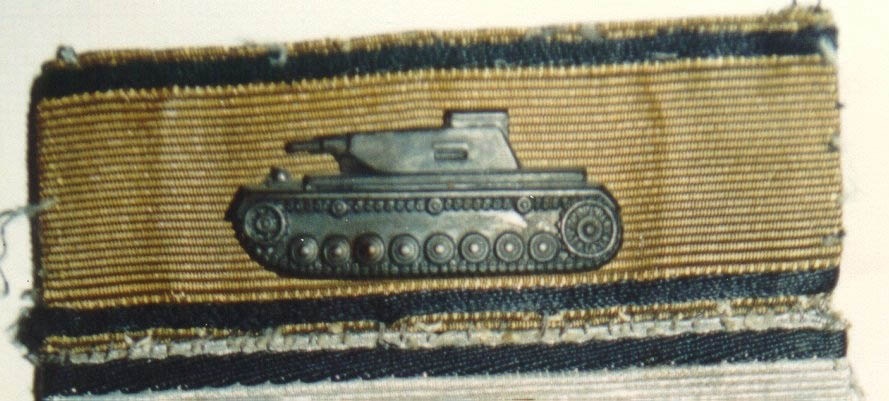
 0
0 -
Here is a Gold PVA. Of course, there were several manufacturers but this gives you a fair idea of what to look for. How many prongs can you feel under the cloth backing glued to the reverse of the badge? Is there a metal backing plate? Is the tank magnetic? Is the backing plate magnetic?
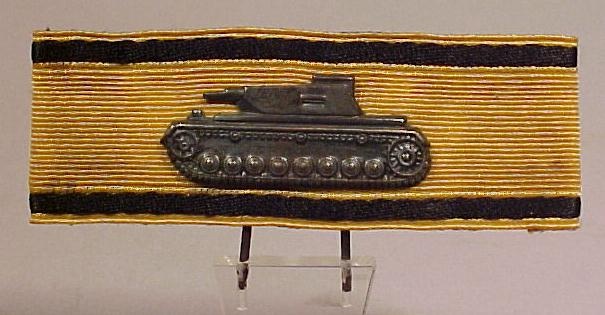
 0
0 -
I agree that better shots of the tank would be helpful. Here is a silver grade PVA. Note the level of detailing of the tank. Note too the direction of the weave of the black borders.
PK
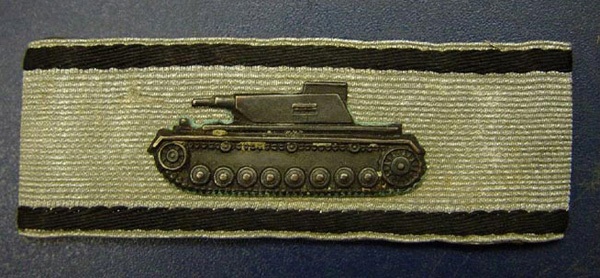
 0
0 -
Here is the other side of the document. You can see that the issuing office, in Germany, was still using its unit stamp complete with the swastika. However, the officer completing the document for Heinrich Karrasch carefully omitted the "SS" designation in front of the two Waffen-SS units cited on the lefthand page and, perhaps at Karrasch's insistence, added a note making it clear that Karrasch had served with the SS-Fallschirmj?ger-Bataillon.
Karrasch began the war as a Luftwaffe mechanic with Lehrgeschwader 1, being transferred late in 1944 to a Heer marsch-kompanie in Bielefeld, where he was recruited by the Kompaniechef of Stab/SS-Fallschirmj?ger-Btl 600 and his team, who were scouring the Heer and Luftwaffe barracks across northern Germany for recruits to bring the new FJ battalion up to full strength.
As you can see, the Heer 'reclaimed' Karrasch. SS-Panzergrenadier Ersatz und Ausbildungs Btl 35 was the nominal depot unit of the SS-Fallschirmj?ger and SS-Jagdverb?nde units. Some sub-units of SS-Panzer-Grenadier-Rgt 7 were placed in Kampfgruppe Solar, formed by Otto Skorzeny for the defence of the Zehden bridgehead and commanded by Siegfried Milius, who was normally commander of SS-Fallschirmj?ger-Btl 600. After the breakout from Zehden, Karrasch evidently found himself with the remains of this unit, and some officer was kind enough to annotate his paybook, otherwise the military police might have arrested him as a deserter.
Interesting that although they went to the trouble of comouflaging his half-year with the Waffen-SS, the document still indicates his service with the SS-FJ-Btl. One wonders if this was due to pride in having served with the Fallschirmj?ger. The annotation "B. -Schein" is interesting. Nobody has yet come up with any explanation for it. Could it mean "Bew?hrungs-Schein"? The original SS-FJ-Btl had been formed with a percentage of Bew?hrungs-Sch?tzen (Disciplinary Soldiers) but the survivors were all "rehabilitated" by the time the remnants of SS-FJ-Btl 500 were transferred to northern Germany as cadre for the new parachute battalion.
It is known that the 180-odd survivors who managed to surrender to US forces with the Soviets snapping at their heels escaped being turned over to certain death at the hands of the Reds by playing hard on the reputation of the unit as a probationary or rehabilitation unit for "politicals", in other words, anti-Nazis. Was this document filled out thus to help Karrash to get home without too many problems? Sadly, he died quite a few years ago and none of his family are really willing to discuss that period. Anyway, just another example of the confusion that reigned at the time...
PK
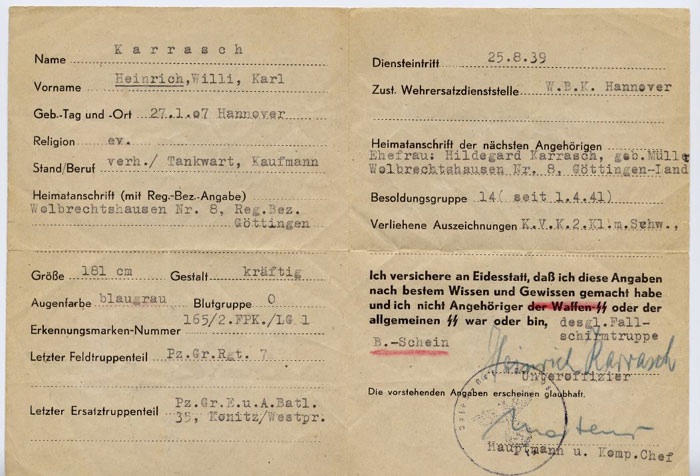
 0
0 -
This Personalkarte was issued in July 1945. Heinrich Karrasch didn't get any Iron Crosses - although he received the KVK2 m. Schw. - but for the sake of discussion of the topic of denazification, I trust you will tolerate this intrusion into the Iron Cross section in order to illustrate some of the strange things one sees in late or immediately postwar documents.
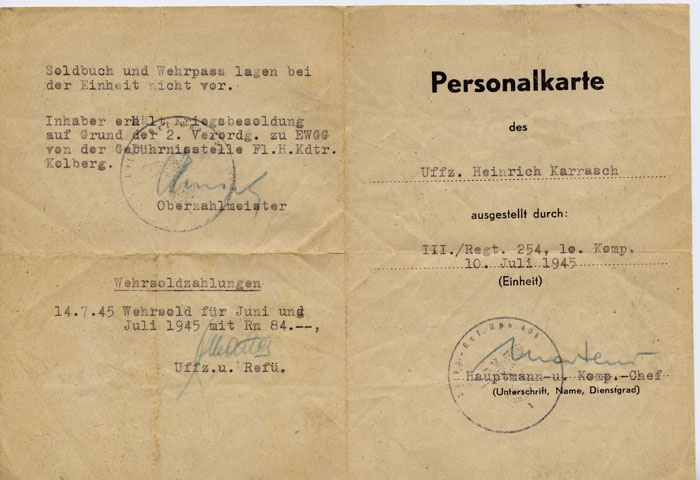
 0
0 -
Interestingly, although the swastikas have been covered, the sigrunen remain visible. This officer only denazified his paybook. None of his other documents were denazified.
PK

 0
0 -
Quite a document! Here's an example of the kind of denazified soldbuch I was referring to. This is the awards page. This remains more or less on-topic as Scheu got the EK2 and EK1 and this is about denazified awards and documents. However, his urkunden are not denazified.
PK
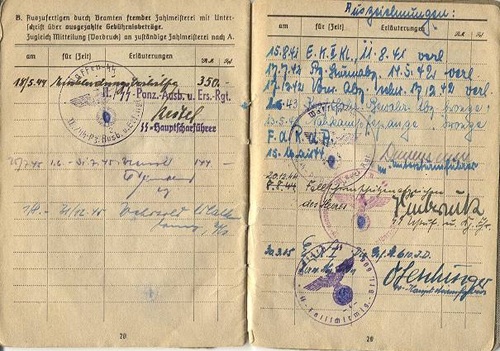
 0
0 -
Posting it here will not contravene any copyright laws. It would come under 'Fair Use' provisions in the legislation, particularly as this is a non-profit website for information-sharing and educational purposes. Just credit the source. You already have credited the source! So let's see the document.
I agree that denazified awards are just as valid as 'intact' pieces. I have a few denazified paybooks and documents, which underlines the fact that the veteran used them after the war for various administrative purposes. Those ink spots over the swastikas are part of history, just as the removed swastikas on your Iron Crosses are part of history, indicating that the holders wore them after the war.
PK
0 -
The wings as awarded usually have the issue number impressed on the reverse. At least, they did. Maybe this isn't done anymore. Of all the French wings I have seen in shops and flea markets, I can count the numbered examples on the fingers of one hand. Obviously, many French paras and paras from other countries who earned French wings buy spare badges for everyday purposes but the lack of numbered examples on the market is interesting.
PK
0 -
Aha! Then you may remember this vista with the lake to one side as you piled out of the Transall...
PK
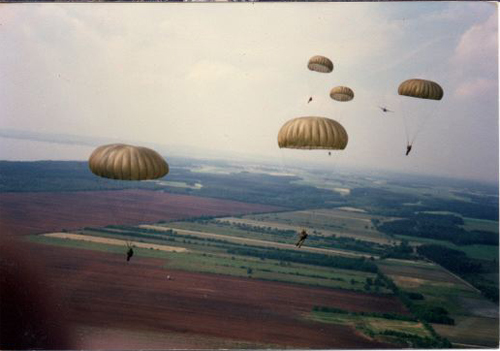
 0
0 -
Click here to see the sale. I'm also uploading the images. This badge was discussed on other forums and the concensus was that it was a fake. In fact, it is an extremely rare "transitional" Fallschirmsch?tzenabzeichen (Heer) with the deformity around the first pattern eagle's talons caused by the makers' attempt to strengthen that area of the die. Only a handful of these are known, one of which is the 800 silver version that belonged to Ludwig Eger and which is currently being offered for sale by Eric Queen.
The other examples are issue aluminium pieces, of which just three are known to date. Sadly, I got there too late. Someone had evidently made the vendor an offer he couldn't refuse and gotten the sale stopped. But it was faintly amusing to watch the forum discussions because some of the participants cited Eric Queen's book Red Shines The Sun, in which at least two of these "transitional" badges are clearly featured. The swastika has clearly been airbrushed out to comply with eBay rules. However, the badge is absolutely intact, with its fragile aluminium hook unbroken.
Sometimes one sees real pearls on eBay...
PK
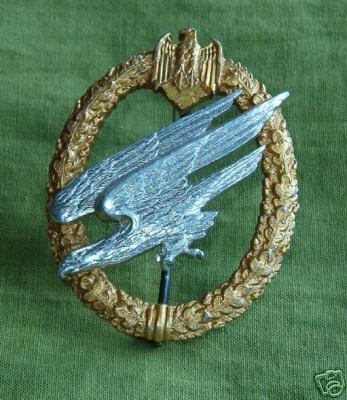
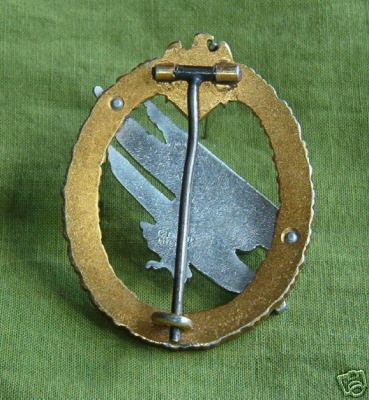

 0
0




FJ Wehrpass Group
in Germany: Third Reich: Research, Documentation & Photographs
Posted
Simon asked for my input but I only just saw this so hopefully it's not too late. What a wonderful Normandy group! Fallschirmj?ger-Rgt 9 was formed in January 1944 and virtually annihilated in the Falaise Gap in August 1944. Reformed, the new regiment was again wiped out in March 1945. I love the reference to combatting "terrorists" at Maubeuge on 2.9.1944 on his close combat days attestation.
Fallschirmschule 4 was set up at Dreux in 1942 but renamed Fallschirmschule 1 late in 1943, although it had nothing to do with the original Fallschirmschule 1 set up in Stendal in 1936, the Fallschirmshule 4 designation being given to a new facility at Salzwedel.
One sees tradition badges entered into paybooks sometimes. In some cases, divisions and units even made up award certificates for them. Jean-Yves Nasse has a soldbuch with a Komet entry made in 1945. This is the first 3. FJD entry I have seen although I have heard of them. Your man was probably given the badge to make the point that he was an original member of the regiment and its division and a veteran of Normandy.
Below is an original 3. FJD tradition badge. This is the horizontal pin type. The more common type - relatively speaking as these badges are very scarce - has a horizontal pin. They were worn on the side of the 1943 pattern field cap but I have one photo, taken in the Breton toen of Huelgoat on the day of Richard Schimpf's arrival in February 1944 to take command of the division, showing a divisional staff officer wearing one on the pocket of his four-pocket tunic, in the manner of the squadron badges worn by flyers.
FJR9 was stationed in and around the coastal town of Daoulas. Raised in Reims under Hauptmann Bodo G?ttsche and commanded by Major Kurt Stephani from 1.2.1944 until his death in action at Falaise on 20.8.1944 was virtually annihilated at Falaise. Major Friedrich Alpers assumed temporary command of the survivors until 3.9.1944 before handing over to Obstlt Gundolf Freiherr Schenk zu Schweinsberg in Belgium, where FJR 9 was also reformed.
Here is an extract from a chapter for a book on the Fallschirmj?ger in France which I never bothered completing after I realised the publishers were muppets. You might find it interesting to see where young Fellhofer got his Erdkampf and Verwundetenabzeichen.
PK